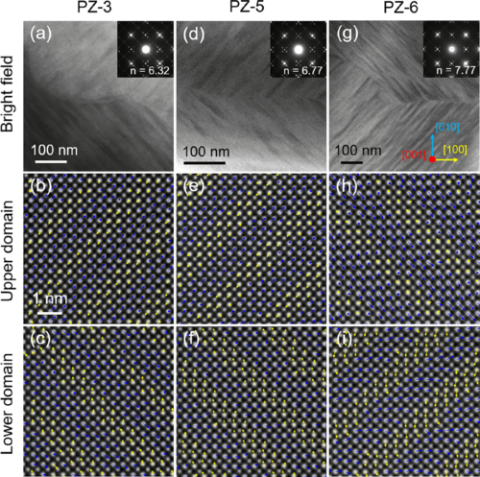The U.S. Department of Energy Ames Laboratory’s capabilities in viewing materials atom-by-atom at its Sensitive Instrument Facility (SIF) regularly helps scientists discover new rules of quantum behavior. Now, the Laboratory’s powerful microscopes have corrected a long held structural model in a class of materials called antiferroelectrics.

Scientists from Ames Lab and Iowa State University were scrutinizing the atomic ordering of a widely-studied group of antiferroelectrics— PbZrO3, lead- and zirconium-based perovskites. Their development is important to electronics and wind and solar energy storage, so improvements in their performance and efficiency are highly sought.
The researchers used a technique called high angle dark-field scanning transmission electron microscopy (HAADF-STEM) to map the crystal structure of the materials. “This technique is highly sensitive to both atomic column’s location and elemental composition,” said Zhou, a materials scientist and microscopy expert at the SIF.
Antiferroelectrics are materials that arrange in such a way that adjacent electric dipoles are flipped in alternating and opposite directions from each other. In that form, the material’s atomic ordering has what is called a commensurate modulation. But PbZrO3 is often doped with other elements, like tin and titanium, to make it more useful in applications. While these additions shift the atomic ordering to an incommensurate modulation type, traditional theories held that the overall polarization of the two types was the same.
“By mapping the relative position shift of Pb in the structure, we found these incommensurate structures did not cancel their polarization in neighboring stripes, but were building a native polarization field in each domain,” said Zhou. “Through our imaging and measurement, we learned that the more titanium that was added into the crystal, the higher the net polarization. This was a total surprise.”
Further theoretical work supports a correction to the old model, and the improved understanding of the materials’ properties and behavior should assist scientists in developing better materials for applications.
The research is further discussed in the paper, “Uncompensated Polarization in Incommensurate Modulations of Perovskite Antiferroelectrics,” authored by Tao Ma, Zhongming Fan, Bin Xu, Tae-Hoon Kim, Ping Lu, Laurent Bellaiche, Matthew J. Kramer, Xiaoli Tan, and Lin Zhou; and published in Physical Review Letters. The work was supported by the National Science Foundation, the Office of Naval Research, and the Defense Advanced Research Projects Agency.
Ames Laboratory is a U.S. Department of Energy Office of Science National Laboratory operated by Iowa State University. Ames Laboratory creates innovative materials, technologies and energy solutions. We use our expertise, unique capabilities and interdisciplinary collaborations to solve global problems.
Ames Laboratory is supported by the Office of Science of the U.S. Department of Energy. The Office of Science is the single largest supporter of basic research in the physical sciences in the United States, and is working to address some of the most pressing challenges of our time. For more information, please visit https://energy.gov/science.
Contacts:
Lin Zhou, Division of Materials Sciences and Engineering, 515-294-7590
Laura Millsaps, Ames Laboratory Communications, 515-294-3474
